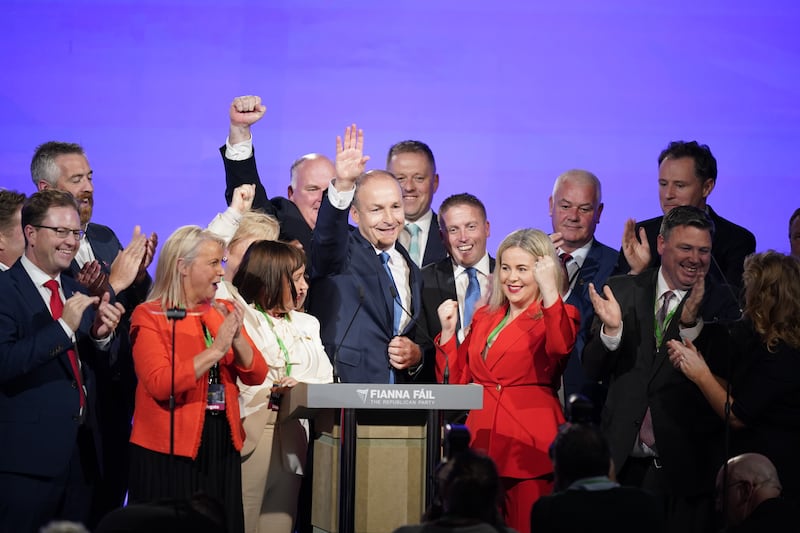He didn’t quite send them home sweatin’ as might have been expected in the old days but Taoiseach and Fianna Fáil leader Micheál Martin was rapturously received at his party’s ardfheis in the RDS over the weekend.
Reports that members were shunning the event proved exaggerated as about 2,500 party loyalists showed up, along with observers and guests; RDS staff were wheeling in stacks of extra chairs before Martin’s keynote Saturday evening address, and there were queues to get into the auditorium. It is, of course, a long time since Fianna Fáil has had a Taoiseach address the faithful at an ardfheis.
And the clock is ticking on that one, with Martin due to vacate the Taoiseach’s office and move to the role of tánaiste in mid-December. That will inevitably diminish the authority he currently enjoys. Though the membership – among whom Martin has always been more popular than among his parliamentary party – seemed quite happy for the party leader to continue indefinitely, few of the TDs believe that he will lead them into the next general election.
How that process evolves over the next 12-18 months is one of the two big questions currently facing the party. If Martin does seek to stay in his post, and lead the party into the next election, he is unlikely to do so without overcoming some sort of challenge from within the ranks of his own TDs. Enough of them have already said so to make that an inevitability.
READ MORE

It seems likely that Martin, whose political judgment has generally proved sharper than many of those who would challenge him, will seek to work with and manage that process rather than stand against it.
And if it is hard to see an obvious successor – though there was a queue of people seeking selfies with Minister for Public Expenditure Michael McGrath at one point; read into that what you will – it’s also true that Martin will not go on forever.
Read more:
Fianna Fáil Árdfheis: Taoiseach says party ‘putting action first’ and promises ‘real progress’
Fianna Fáil Árdfheis: New party objectives include defending democracy and climate action
Taoiseach does not envisage ‘mini-budget’ in January
Fianna Fáil at crossroads but Martin in command of his own destiny
The second great question that Fianna Fáil must address in the medium-term future is the possibility of Coalition with Sinn Féin after the next election. There was plenty of old-time religion for the delegates with motions about a united Ireland and the conference seemed to be making a concerted effort to reclaim the “republican” tag, but Sinn Féin’s ascendancy in the polls isn’t driven by its advocacy for a united Ireland – it’s driven, largely, by the chronic shortage of affordable housing available to younger voters. And that’s not going to be solved by motions at the ardfheis or rounds of applause for Fianna Fáil’s stewardship of the peace process.
Minister for Education Norma Foley was the warm-up – a term to be used advisedly – speaker for Martin on Saturday evening, and she spent much of her speech, to the delight of delegates, bashing Sinn Féin. It’s the sort of thing they used to reserve for Fine Gael or the PDs, and the hall lapped it up. In conversations over the weekend, delegates and TDs seemed unenthusiastic about the prospect of a Coalition with Sinn Féin, but few wanted to rule it out completely.
It is now over a decade since the obituaries for Fianna Fáil were widely written. Well, the party is not dead yet. It lives; smaller, maybe more timorous, slightly unsure of itself and rather fearful about the future. But still leading the Government, with the largest number of TDs in the Dáil (just about), the largest party of local government; it lives. However, it has some big decisions to make. The weekend’s ardfheis didn’t tell us much about how it will go about making those decisions. But they are unavoidable.










